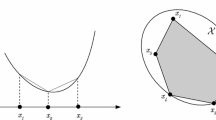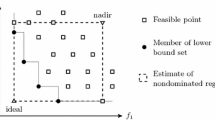Abstract
When a column generation approach is applied to decomposable mixed integer programming problems, it is standard to formulate and solve the master problem as a linear program. Seen in the dual space, this results in the algorithm known in the nonlinear programming community as the cutting-plane algorithm of Kelley and Cheney-Goldstein. However, more stable methods with better theoretical convergence rates are known and have been used as alternatives to this standard. One of them is the bundle method; our aim is to illustrate its differences with Kelley’s method. In the process we review alternative stabilization techniques used in column generation, comparing them from both primal and dual points of view. Numerical comparisons are presented for five applications: cutting stock (which includes bin packing), vertex coloring, capacitated vehicle routing, multi-item lot sizing, and traveling salesman. We also give a sketchy comparison with the volume algorithm.
Similar content being viewed by others
References
Anstreicher, K., Wolsey, L.A.: On Dual Solutions in Subgradient Optimization. Unpublished manuscript, CORE, Louvain-la-Neuve (1993)
Augerat, P.: VRP problem instances (1995) http://www.branchandcut.org/VRP/data/
Barahona F. and Anbil R. (2000). The volume algorithm: Producing primal solutions with a subgradient method. Math. Program. 87(3): 385–399
Beasley, J.E.: Or-library: distributing test problems by electronic mail. J. Oper. Res. Soc. 41(11), 1069–1072 (1990) http://mscmga.ms.ic.ac.uk/jeb/orlib/binpackinfo.html
Ben-Amor, H., Desrosiers, J.: A proximal-like algorithm for column generation stabilization. Technical report G-2003-43, Les Cahiers du Gerad, Montréal (2003)
Benameur, W., Neto, J.: Acceleration of cutting plane and column generation algorithms: application to network design (to appear, 2006)
Cheney E. and Goldstein A. (1959). Newton’s method for convex programming and Tchebycheff approximations. Numer. Math. 1: 253–268
COmputational INfrastructure for Operations Research: http://www.coin-or.org
Dash Optimization: Xpress-MP: User guide and reference manual, release 12 (2001) http://www.dashoptimization.com
Degraeve Z. and Peeters M. (2003). Optimal integer solutions to industrial cutting stock problems: part 2: benchmark results. INFORMS J. Comput. 15(1–3): 58–81
du Merle O., Villeneuve D., Desrosiers J. and Hansen P. (1999). Stabilized column generation. Disc. Math. 194(1–3): 229–237
Ermol’ev Y.M. (1966). Methods of solution of nonlinear extremal problems. Kibernetica 2(4): 1–17
Feillet D., Dejax P., Gendreau M. and Gueguen C. (2004). An exact algorithm for the elementary shortest path problem with resource constraints: application to some vehicle routing problems. Networks 44(3): 216–229
Frangioni A. (2003). Generalized bundle methods. SIAM J. Optim. 13(1): 117–156
Gau T. and Wäscher G. (1995). CUTGEN1: a problem generator for the standard one-dimensional cutting stock problem. Eur. J. Oper. Res. 84: 572–579
Geoffrion A.M. (1974). Lagrangean relaxation for integer programming. Math. Program. Study 2: 82–114
Goffin J.-L., Haurie A. and Vial J.-Ph. (1992). Decomposition and nondifferentiable optimization with the projective algorithm. Manage. Sci. 38(2): 284–302
Goffin J.-L., Luo Z.-Q. and Ye Y. (1996). Complexity analysis of an interior cutting plane for convex feasibility problems. SIAM J. Optim. 6(3): 638–652
Goffin J.-L. and Vial J.-Ph. (2002). Convex nondifferentiable optimization: a survey focused on the analytic center cutting plane method. Optim. Methods Softw. 17(5): 805–867
Held M. and Karp R. (1970). The traveling salesman problem and minimum spanning trees. Oper. Res. 18: 1138–1162
Held M. and Karp R. (1971). The traveling salesman problem and minimum spanning trees: part II. Math. Program. 1(1): 6–25
Hiriart-Urruty, J.-B., Lemaréchal, C.: Convex Analysis and Minimization Algorithms. Springer, Berlin Heidelberg New York (1993, Two volumes)
Hiriart-Urruty J.-B. and Lemaréchal C. (2001). Fundamentals of Convex Analysis. Springer, Berlin Heidelberg New York
Kelley J.E. (1960). The cutting plane method for solving convex programs. J. Soc. Indust. Appl. Math. 8: 703–712
Kim S., Chang K.N. and Lee J.Y. (1995). A descent method with linear programming subproblems for nondifferentiable convex optimization. Math. Program. 71(1): 17–28
Kiwiel K.C. (1989). A dual method for certain positive semidefinite quadratic programming problems. SIAM J. Sci. Stat. Comput. 10(1): 175–186
Kiwiel K.C. (1983). An aggregate subgradient method for nonsmooth convex minimization. Math. Program. 27: 320–341
Kiwiel K.C. (1985). Methods of Descent for Nondifferentiable Optimization. Lecture Notes in Mathematics 1133. Springer, Berlin Heidelberg New York
Kiwiel K.C. (1994). A Cholesky dual method for proximal piecewise linear programming. Numer. Math. 68: 325–340
Kiwiel, K.C.: An inexact bundle approach to cutting stock problems. Technical report, Systems Research Institute, Warsaw. Submitted to INFORMS J. Comput. (2004)
Kiwiel K.C. (2006). A proximal bundle method with approximate subgradient linearizations. SIAM J. Optim. 16(4): 1007–1023
Kiwiel, K.C., Lemaréchal, C.: An inexact conic bundle variant suited to column generation (in preparation)
Sagastizábal C., Bahiense L. and Maculan N. (2002). The volume algorithm revisited: relation with bundle methods. Math. Program. 94(1): 41–69
Larsson T., Patriksson M. and Strömberg A.B. (1999). Ergodic, primal convergence in dual subgradient schemes for convex programming. Math. Program. 86(2): 283–312
Lemaréchal, C.: An algorithm for minimizing convex functions. In: Rosenfeld, J.L. (ed.) Information Processing ’74, pp. 552–556. North Holland, Amsterdam (1974)
Lemaréchal, C.: Nonsmooth optimization and descent methods. Research Report 78-4, IIASA (1978)
Lemaréchal, C.: Lagrangian relaxation. In: Jünger, M., Naddef, D. (eds.) Computational Combinatorial Optimization, pp. 112–156. Springer, Berlin Heidelberg New York (2001)
Lemaréchal, C.: The omnipresence of Lagrange. 4OR 1(1), 7,25 (2003)
Lemaréchal C., Nemirovskii A.S. and Nesterov Yu.E. (1995). New variants of bundle methods. Math. Program. 69: 111–148
Lemaréchal, C., Pellegrino, F., Renaud, A., Sagastizábal, C.: Bundle methods applied to the unit-commitment problem. In: Dolež al, J., Fidler, J. (eds.) System Modelling and Optimization, pp. 395–402. Chapman and Hall, London (1996)
Lemaréchal C. and Sagastizábal C. (1997). Variable metric bundle methods: from conceptual to implementable forms. Math. Program. 76(3): 393–410
Marsten R.E., Hogan W.W. and Blankenship J.W. (1975). The boxstep method for large-scale optimization. Oper. Res. 23(3): 389–405
Mehrotra A. and Trick M.A. (1996). A column generation approach to graph coloring. INFORMS J. Comput. 8(4): 344–354
du Merle O., Villeneuve D., Desrosiers J. and Hansen P. (1999). Stabilized column generation. Discrete Math. 194: 229–237
Nemirovskii, A.S., Yudin, D.: Informational complexity and efficient methods for the solution of convex extremal problems. Ékonomika i Mathematicheskie Metody 12, 357–369 (1976) (in Russian. English translation: Matekon 13, 3–25)
Nemirovskii, A.S., Yudin, D.: Problem Complexity and Method Efficiency in Optimization. Wiley-Interscience Series in Discrete Mathematics (1983). (Original Russian: Nauka, 1979)
Nesterov Yu.E. (1995). Complexity estimates of some cutting plane methods based on the analytic barrier. Math. Program. 69(1): 149–176
Nesterov Yu.E. and Vial J.-Ph. (1999). Homogeneous analytic center cutting plane methods for convex problems and variational inequalities. SIAM J. Optim. 9(3): 707–728
Polyak B.T. (1967). A general method for solving extremum problems. Soviet Math. Doklady 8: 593–597
Prim R.C. (1957). Shortest connection networks and some generalizations. Bell Syst. Technol. J. 36: 1389–1401
Rockafellar R.T. (1970). Convex Analysis. Princeton University Press, Princeton
Rockafellar R.T. (1973). A dual approach to solving nonlinear programming problems by constrained optimization. Math. Program. 5: 354–373
Rousseau, L.-M., Gendreau, M., Feillet, D.: Interior point stabilization for column generation. Working paper 39, Centre de Recherche sur les Transports, Univ. Montréal (2003)
Shor N. (1970). Utilization of the operation of space dilatation in the minimization of convex functions. Cybernetics 6(1): 7–15
Shor N.Z. (1985). Minimization methods for non-differentiable functions. Springer, Berlin Heidelberg New York
Thiongane B., Nagih A. and Plateau G. (2004). Adapted step size in a 0-1 biknapsack lagrangean dual solving algoritm. Ann. Oper. Res. 139(1): 353–373
Uzawa, H.: Iterative methods for concave programming. In: Arrow, K., Hurwicz, L., Uzawa, H. (eds.) Studies in Linear and Nonlinear Programming, pp. 154–165. Stanford University Press, Stanford (1959)
Vanderbeck F. (2002). Extending Dantzig’s bound to the bounded multi-class binary knapsack problem. Math. Program. 94(1): 125–16
Vanderbeck, F.: Dantzig-Wolfe re-formulation or how to exploit simultaneaously original formulation and column generation re-formulation. Working paper U-03.24, University Bordeaux 1, Talence (2003)
Author information
Authors and Affiliations
Corresponding author
Additional information
This research has been supported by Inria New Investigation Grant “Convex Optimization and Dantzig-Wolfe Decomposition”.
Rights and permissions
About this article
Cite this article
Briant, O., Lemaréchal, C., Meurdesoif, P. et al. Comparison of bundle and classical column generation. Math. Program. 113, 299–344 (2008). https://doi.org/10.1007/s10107-006-0079-z
Received:
Accepted:
Published:
Issue Date:
DOI: https://doi.org/10.1007/s10107-006-0079-z
Keywords
- Lagrangian duality
- Dantzig–Wolfe decomposition
- Stabilized column generation
- Cutting-plane algorithms
- Bundle algorithm
- Volume algorithm
- Nonsmooth convex optimization




